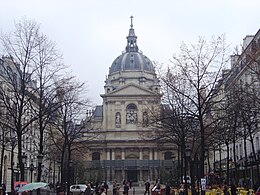Paris-Sorbonne University: Difference between revisions
No edit summary |
No edit summary |
||
| Line 18: | Line 18: | ||
'''Paris-Sorbonne University (Paris IV)''' is a university in [[Paris]], [[France]]. To a large extent, Paris-Sorbonne University was the inheritor of the former University of Paris’ Arts and Sciences Faculties. |
'''Paris-Sorbonne University (Paris IV)''', ({{lang-fr|Université Paris-Sorbonne (Paris IV)}}), is a university in [[Paris]], [[France]]. To a large extent, Paris-Sorbonne University was the inheritor of the former University of Paris’ Arts and Sciences Faculties. |
||
==History== |
==History== |
||
Revision as of 10:30, 18 March 2008
 | |
| Type | Public |
|---|---|
| Established | 1971, following the division of the University of Paris (1253) |
| Chancellor | Maurice Quénet Chancellor of the Universities of Paris |
| President | Georges Molinié |
| Students | 23 324 |
| Undergraduates | 13 900 |
| Postgraduates | 6 916 |
| 2 508 | |
| Location | , |
| Website | www.paris-sorbonne.fr |
Paris-Sorbonne University (Paris IV), (French: Université Paris-Sorbonne (Paris IV)), is a university in Paris, France. To a large extent, Paris-Sorbonne University was the inheritor of the former University of Paris’ Arts and Sciences Faculties.
History
Origins
The historic University of Paris (French: Université de Paris) first appeared in the second half of the 12th century, but was in 1970 reorganised as 13 autonomous universities (University of Paris I–XIII). The university is often referred to as the Sorbonne or La Sorbonne after the collegiate institution (Collège de Sorbonne) founded about 1257 by Robert de Sorbon, but the university as such was older and was never completely centred on the Sorbonne.
After May 1968
In 1971, after the university reforms (Framework law drawn up by Edgar Faure in 1968), the five faculties of the former University of Paris were split and then re-formed into thirteen interdisciplinary universities.
Four of these new universities now share the premises of the Sorbonne building, which, until that time, had been mainly reserved for the Faculties of Arts and Human Sciences. These four universities were also given other premises in different locations throughout Paris. Three universities have kept the Sorbonne name as part of their official title: Paris-Sorbonne (Paris IV), the New Sorbonne (Sorbonne Nouvelle, Paris III), which is located mainly in the Censier buildings, and the Panthéon-Sorbonne (Paris I). The Sorbonne premises also house part of the René Descartes University (Paris V) and the Chancellery (Education authority of Paris - rectorat de Paris).
Toward a global university

In 2006, the Paris-Sorbonne university and the United Arab Emirates signed a cooperation agreement for the creation of the new University Paris-Sorbonne-Abu Dhabi. It is the first time that a French university is established abroad.
Following the election of the Philologist George Molinié to the presidency in March 2008 the Paris-Sorbonne University should join Paris Universitas.[1]
Paris-Sorbonne University today
In the The Times Higher Education Supplement (THES) - QS World University Rankings 2007 - the Paris-Sorbonne University was ranked 29 for Arts & Humanities.
Campus

The main teaching centres are:
Central Sorbonne Building
Malesherbes
Clignancourt
Michelet
Championnet
Paris-Sorbonne University Abu Dhabi Campus
Presidents
Since its creation, it has been governed by five presidents; the founding president, historian Alphonse Dupront, was succeeded by the philosopher Raymond Polin, who was followed by Hellenist Jacques BOmpaire. Next came religious historian Michel Meslin and then Jean-Pierre Poussou, a historian of the urban and contemporary world. In May 1998, Georges Molinie, a specialist in modern French stylistics, was elected and, since May 2003, the president is geographer Jean-Robert Pitte.
Their initiatives have been aimed at promoting the cultural heritage of the Sorbonne, with a focus on disciplines in the literary and human science fields. This purpose will be furthered by giving top priority to the study of civilizations and to the continuance of strong teaching in the classics. The various presidents have also provided the impetus for numerous innovations whose aim has been to adapt the education given at the Sorbonne to the demands of the 21st century. Because one of the main concerns of the university is the integration of students into the working world, it facilitates internships, has created increasingly work-oriented courses of study for students of the Arts and has organized numerous courses aimed at preparing students for competitive civil service exams. It also hosts the CELSA school of journalism, a grande école inside the University.
See also
References
External links
The official site :
